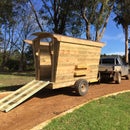Introduction: 1HP Electric Car
This instructable gives an overview of building two small cars from the ground up, both powered by electric bike motors. The build includes chassis, fibreglass body, steering and drive train. The cars are designed for efficiency to extract the maximum performance from a 1hp motor and were used to compete in an electrathon competition. It can be built for around $1500 including motor, controller and the latest lithium batteries and will go flat out around 50km/h for 1 hour before recharging.
Similar in size to a gokart, Roadbot 3 and Roadbot 4 have streamlined bodies, minimal frontal area and low rolling resistance tyres. They are powered by brushless DC electric motors and a lithium battery packs.
They were built to compete in the Perth EV Challenge in Western Australia by the River Raiders team.
Step 1: Planning and Models
After doing some drawings and measuring up the drivers, a scale foam body model is made from polystyrene foam and a full scale ergonomic study is made from plywood. The shape of the sides shows how the vehicle profile will look and identifies a couple of places we can shave a bit off the cross sectional area.
This year we are using 20” wheels and are building 3 and 4 wheel cars. The 20” rear wheel, down from 26” in previous years allows a more reclined driving position which reduces the frontal area. The 20" wheels are also stronger for side loads than large bike wheels (note a bike does not apply side loads to a wheel when cornering) but have a slightly higher rolling resistance however at speeds over about 30km/h, reducing wind drag becomes more important than rolling resistance.
Step 2: Building the Body
The body is made in the following steps
1. Drawing up plans to determine the smallest aerodynamic package
2. Make a foam model
3.Make a full size plug
4. Make a fibreglass mould from the plug
5. Make a fibreglass body in the mould
The Plug
It started off looking more like a flintstone’s car! I found an old pine log in the paddock that was big enough to carve a plug for the body from and cut two large slabs, one each for the top and bottom car body.
Reasons for using a log are twofold, firstly cost - had an old log in the paddock so doesn’t cost anything other than the time and secondly the timber will give a stronger more rigid surface than foam to mould onto. Timber can be formed easily with woodwork tools and can be finished easily to a good quality surface. After the plug was completed it was sprayed with gloss varnish and given several coats of mould release wax and sprayed with a pva mould release film
Fibreglass Mould
The plug was cut longitudinally into 4 quarters. See photos to clarify how the plug was cut. This enabled the plug to sit flat on a melamine particle board which provides and smooth, flat surface for mould joins. For the first quarter mould, a second smaller melamine board was used at right angles to the first board to create a second mould joint plane.
I won't go into any detail on fibreglass layup as there are other good instructables on fibreglass. We used three layers of chopped strand mat with polyester resin for the mould. In the corners the glass matting needs a gentle radius so we mixed wood fibre (sawdust from sanding) with some resin to smooth out any tight bends before laying up the glass matting.
After the mould has set (allow a few days to harden) bolting holes were drilled along the joints before removing from the plug. The holes will be used to align and assemble the mould after the plug is removed.
Body
The mould was polished and wax, reassembled in two halves and the internal surfaces coated with mould release agent. Don't rush or skimp on this step or the body will stick to the mould and be very hard to remove and may damage the mould.
After waxing and applying pva mould release, one layer of woven mat and one layer of chopped strand matt were layed up in the mould by hand. A team of three people made it easier to complete including handling cloth, working quickly with resin before setting and wetting out the cloth and eliminating air bubbles in the fibreglass. Its a smelly, messy job but there are very few alternatives for a cheap, light, strong, curved body skin.
After release, trim the flanges and cut a hole for the driver.
Step 3: Steering
The steering follows basic ackerman principals, that is the steering pivot points are in a line between the steering pivot (king pin) and the centre of the rear wheel. This results in a different steering angle for each wheel - the outer wheel having a slightly large radius and smaller angle when turning than the inner wheel. If there was no allowance for the different steering angles between the inner and outer wheels the car would still work OK but there would be tyre scrub when turning and would not be as efficient of fast through bends.
A model was made using ply and nails to represent steering joints to test the steering geometry before fabricating.
The steering was made by welding a stub axel turned from 14mm rod onto a piece of 14mm steel tubing. The inside diameter of the tubing was 10mm, neatly pivoting on a 10mm (3/8") bolt. The stub axel pivoted in a U shaped bracket bent from 4mm steel bar and the back of the U bracket was welded to a 25mm (1") square hollow tube.
Looking at the steering from the front, the steering pivot (king pin) is not vertical, an angle of about 10 degrees (king pin angle) reduces steering scrub and makes the steering self centre, improving stability. From the side the king pin is angled at about 5 degrees (caster angle). Also the wheels are not completely vertical, they have a slight camber. Camber is usually provided on road cars so the tyre sits flat and has more grip allowing for some roll when cornering. In this case the reason for camber is very different. We are not looking for grip, but a little bit of camber helps offset some of the side loading on the outer wheel when cornering, a bit like a bike leaning into a bend.
There is no suspension here - its designed for a smooth track. Creature comforts are not important, efficiency is the main goal.
Step 4: Chassis
Here keeping it simple is best. The weak points are probably the welds, so we keep these to a minimum. This also help make it quicker to build. Essentially the chassis comprises two 25mm (1") thin wall square hollow steel tubes, one each side of the driver with another for the axle at the front. The three wheel car has a couple of tubes welded on like a horizontal rear fork.
The four wheel car is more complex. It uses a small chain drive diff from a tricycle supplier. It also has swing arm axles with rubber stoppers for suspension. The suspension is not for comfort, but is required to keep all four wheels on the road.
Step 5: Drive Train
The obvious source of motors for a small electric car are the bike kits that are cheaply and widely available. They range from as low as 200w to over 1500w. The motors usually come matched to a controller and a battery pack is used to suit the voltage and range required.
The first choice to make is whether to use a hub motor or a chain drive. A hub motor is simpler and more reliable, but cannot adjust the gearing and tends to be limited to about 40km/h maximum speed. With a chain drive motor, the gearing can be adjusted and speeds can be alot higher for an aerodynamic body.
We used an 800w brushless dc motor and the lithium battery pack voltage and size was determined to suit the rules of the competition which limited the battery pack to 36volt 5kg maximum.
The use of standard bike components meant that chain sprockets and brake discs could be bolted direct to the wheels.
Step 6: Bringing It Together
The bottom of the body rivets directly to the main chassis tubes and the top half of the body joins by pivoting at the front on a repurposed door hinge.
Add paint, graphics, a windscreen to complete a simple electric car.
Step 7: Testing the Drive Train
Step 8: Race Day
Roadbot 3 was fastest on track setting a lap record and still had battery capacity at the end of the race. Roadbot 4 was about third fastest on track and the battery pack and could not use its full speed if it was to make the full race distance because of the extra current draw from the motor.
After a botched pit stop (rules require two mandatory pit stops) where the next driver was missing, Roadbot 3 recovered ground to finish second overall.
Picture (l-r): Wayne, Rod and Jamie, the River Raiders Team
Acknowledgement: EV Power supplied batteries and battery management for the cars.
2012 ITC Global Perth EV Challenge Official Event Video
http://youtu.be/i2-fg-HefL8
River Raiders Race Footage

Participated in the
Workshop Contest













